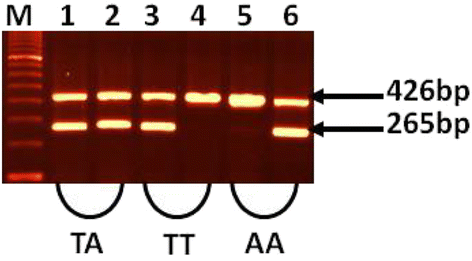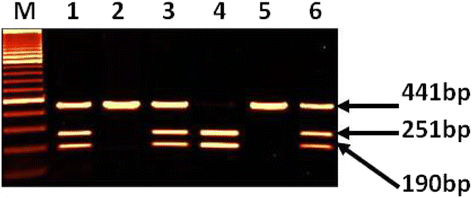Association of genetic polymorphisms in interferon-γ, interleukin-6 and transforming growth factor-β1 gene with oral lichen planus susceptibility
- PMID: 27544215
- PMCID: PMC4992569
- DOI: 10.1186/s12903-016-0277-x
Association of genetic polymorphisms in interferon-γ, interleukin-6 and transforming growth factor-β1 gene with oral lichen planus susceptibility
Abstract
Background: Oral lichen planus (OLP) is a premalignant mucocutaneous disease in which genetic factors and immune responses play a major role. Cytokines play an important role in the pathogenesis and disease progression of OLP. The aim of this study was to investigate the impact of gene polymorphisms of T helper cell subtype Th1 and Th2 cytokines, interferon-gamma (IFN-γ), interleukin-6 (IL-6) and transforming growth factor (TGF)-β1 on OLP susceptibility in a Saudi cohort.
Methods: Forty two unrelated patients with OLP and 195 healthy controls were genotyped for IFN-γ (874A/T), IL-6 (174G/C) and TGF-β1 (509C/T) polymorphisms.
Results: The frequency of genotype AT of IFN-γ (874A/T) was significantly higher while genotype AA was lower in OLP patients as compared to controls (P < 0.05). The frequency of T containing genotypes (AT + TT) was also higher in OLP patients as compared to that in controls (P = 0.003). The frequencies of allele T was higher while that of allele A lower in patients than the controls however the difference was not statistically significant (P = 0.07). There was no significant difference in the frequencies of alleles and genotypes of IL-6 (174G/C) and TGF-β1 (509C/T) polymorphisms between patient and control groups. These results indicated that genotype AT of IFN-γ (874A/T) polymorphism is associated with OLP risk and genotype AA is protective to OLP. On the other hand the polymorphisms IL-6 (174G/C) and TGF-β1 (509C/T) may not be associated with OLP risk in our population.
Conclusion: It is concluded that IFN-γ (874A/T) polymorphism is associated with the susceptibility of OLP, however further studies with large sample size involving different ethnic populations should be conducted to strengthen our results.
Keywords: Interferon-γ; Interleukin -6; Oral lichen planus; Polymorphism; Saudis; Transforming growth factor -β1.
Figures



Similar articles
-
Association of polymorphisms in the human IFN-gamma and IL-4 gene with oral lichen planus: a study in an ethnic Chinese cohort.J Interferon Cytokine Res. 2008 Jun;28(6):351-8. doi: 10.1089/jir.2007.0056. J Interferon Cytokine Res. 2008. PMID: 18593330
-
TNF-α, TNF-β and IL-10 gene polymorphism and association with oral lichen planus risk in Saudi patients.J Appl Oral Sci. 2015 May-Jun;23(3):295-301. doi: 10.1590/1678-775720150075. J Appl Oral Sci. 2015. PMID: 26221924 Free PMC article.
-
Tumor necrosis factor-alpha and interferon-gamma polymorphisms contribute to susceptibility to oral lichen planus.J Invest Dermatol. 2004 Jan;122(1):87-94. doi: 10.1046/j.0022-202X.2003.22108.x. J Invest Dermatol. 2004. PMID: 14962095
-
Inflammation-related cytokines in oral lichen planus: an overview.J Oral Pathol Med. 2015 Jan;44(1):1-14. doi: 10.1111/jop.12142. Epub 2013 Dec 16. J Oral Pathol Med. 2015. PMID: 24329772 Review.
-
Association of IL-6, IL-10 and TGF-β1 gene polymorphisms with brucellosis: A systematic review with meta-analysis.Microb Pathog. 2019 Oct;135:103640. doi: 10.1016/j.micpath.2019.103640. Epub 2019 Jul 22. Microb Pathog. 2019. PMID: 31344477
Cited by
-
Mannose-Binding Lectin 2 (MBL2) combined genotypes deficiency is associated with susceptibility for Oral Lichen Planus.Genet Mol Biol. 2019 Jan-Mar;42(1):9-14. doi: 10.1590/1678-4685-GMB-2018-0015. Epub 2019 Feb 21. Genet Mol Biol. 2019. PMID: 30794720 Free PMC article.
-
IFN-γ enhances cell-mediated cytotoxicity against keratinocytes via JAK2/STAT1 in lichen planus.Sci Transl Med. 2019 Sep 25;11(511):eaav7561. doi: 10.1126/scitranslmed.aav7561. Sci Transl Med. 2019. PMID: 31554739 Free PMC article.
-
Association between polymorphisms in interleukins and oral lichen planus: A meta-analysis.Medicine (Baltimore). 2017 Mar;96(11):e6314. doi: 10.1097/MD.0000000000006314. Medicine (Baltimore). 2017. PMID: 28296743 Free PMC article.
-
Oral lichen planus: a microbiologist point of view.Int Microbiol. 2021 Aug;24(3):275-289. doi: 10.1007/s10123-021-00168-y. Epub 2021 Mar 10. Int Microbiol. 2021. PMID: 33751292 Free PMC article. Review.
-
Rise and exacerbation of oral lichen planus in the background of SARS-CoV-2 infection.Med Hypotheses. 2021 Nov;156:110681. doi: 10.1016/j.mehy.2021.110681. Epub 2021 Sep 20. Med Hypotheses. 2021. PMID: 34601231 Free PMC article.
References
-
- Carrozzo M. Understanding the pathobiology of oral lichen planus. Curr Oral Health Rep. 2014;1:173–9. doi: 10.1007/s40496-014-0022-y. - DOI
MeSH terms
Substances
LinkOut - more resources
Full Text Sources
Other Literature Sources

